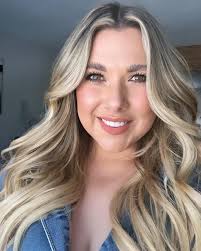Extensions for Fine & Thin Hair: What Actually Works
I've lost count of how many times a client with fine hair has sat in my chair and said, "I've been told extensions will ruin my hair." Or, "Every stylist I've talked to says my hair is too thin."
It makes me so frustrated because it's just not true. Fine hair can absolutely handle extensions. But here's the thing: it requires a completely different approach than what works for thick hair. You can't just scale down the same technique and hope it works. You need someone who actually understands the mechanics of fine hair.
Let me walk you through what I've learned over the years, including the mistakes I've made and what finally clicked.
Can Your Hair Actually Handle Extensions?
Okay, real talk time. Not everyone is a good candidate for extensions right this second. And any stylist worth their salt is going to tell you that upfront, even if it means losing the booking.
When someone with fine hair comes in, I'm looking at a few specific things during the consultation.
First, density. Fine hair and thin hair aren't the same thing. You can have fine individual strands but still have a lot of them, which gives you options. Or you can have fine strands AND low density, which means we need to be really careful about what we add and how much.
I literally count how many hairs are in a section sometimes. If I can see scalp easily through a one-inch section, that's telling me something about how much weight that hair can support.
Second, I'm checking scalp health. If there's redness, flaking, or the client mentions their scalp is always itchy or sensitive, we're not doing extensions that day. I don't care how badly they want them. A compromised scalp is going to react badly to any attachment method.
Third, we talk about what they actually want. Because someone who wants a little volume at the ends is a totally different application than someone who wants long, thick mermaid hair. Sometimes I have to be the person who says, "We can get you closer to that goal, but going all the way there isn't safe for your hair right now."
When I Actually Say No
I've turned people away. Not often, but it happens. If someone is experiencing active hair loss, like they're shedding way more than normal and you can see it's getting thinner by the week, extensions aren't the answer. They need to see a doctor or a trichologist first and figure out what's causing it.
I had a client once who was so set on getting extensions. But her hair was already really compromised from years of tight ponytails and she had visible traction alopecia around her hairline. I told her we needed to let her hair recover first, maybe try clip-ins for special events in the meantime. She was disappointed, but six months later she came back, her hair was healthier, and we were able to do a beautiful application that actually lasted.
Saying no in the moment sucks, but it's way better than having someone come back with more damage and blaming you for it.
Methods That Actually Work for Fine Hair
Alright, so you've determined the client is a good candidate. Now what?
The rule for fine hair is simple: lightweight, flat, and evenly distributed. Anything bulky or heavy is going to create problems.
Tape-Ins
These are probably my go-to for most clients with fine hair. The wefts are thin and they lay completely flat against the head. When they're done right, you legitimately cannot feel them.
Here's how they work: you sandwich a section of natural hair between two adhesive wefts. The adhesive is medical-grade, so it's gentle and doesn't damage the hair when you remove it properly.
For really fine hair, I sometimes do single-sided tape-ins. Instead of two wefts, you use one extension weft and one plain tape tab. Cuts the weight in half and it's still completely secure.
The reason tape-ins work so well is the weight distribution. You're spreading the extension across maybe an inch or more of natural hair, so no single strand is taking all the load. And if you place them correctly, they're invisible even in a high ponytail.
Genius Wefts
If you haven't worked with these yet, they're incredible for fine hair. They're basically a hybrid between hand-tied and machine wefts, and they solve a lot of the problems both methods have.
They're sewn in with beads, similar to hand-tied, but the weft itself is thinner and more flexible. The big advantage is you can cut them to any length without them unraveling. So if you need a shorter piece to fit a specific area, you just cut it. Done.
What I love about Genius Wefts for fine hair is there's no return hair. Traditional wefts have those little short hairs at the top that can poke and itch against the scalp. Genius Wefts don't have that, so they lay flat and smooth. Clients with sensitive scalps especially appreciate this.
Hand-Tied Wefts
These can work beautifully for fine hair, but the stylist's technique matters more here than with other methods.
With hand-tied, you're creating a foundation of tiny beads in the natural hair, then sewing the weft onto that row of beads. The problem is if you use too many beads or place them wrong, you're creating bulk and tension.
I use the absolute minimum number of beads needed to be secure. And I'm really strategic about placement. I'll do a brick-lay pattern so the wefts aren't stacked directly on top of each other. This keeps everything flat and distributes weight better.
When hand-tied is done right, it's comfortable and looks amazing. When it's done badly, it's a nightmare of pulling and visible lumps under the hair.
What I Avoid for Fine Hair
I generally steer clear of traditional fusion or micro-link methods for very fine hair. The problem is you're attaching small amounts of extension hair to small sections of natural hair, which can create focused tension points. One bond pulling on 20 strands of fine hair is asking for breakage.
Can it be done safely? Maybe, by someone who really knows what they're doing. But there are better options that carry less risk, so why take the chance?
The Application Is Everything
Picking the right method is step one. Actually installing it correctly is where everything either works or falls apart.
I spend a lot of time on sectioning with fine hair. The sections have to be clean and precise. If I'm sloppy and grab random pieces, some of that hair is going to be pulled in the wrong direction and create strain.
I also think about quantity differently. With thick hair, you can pack in a lot of extensions and it looks great. With fine hair, less is more. I'd rather underdo it slightly and have the client come back wanting a little more than overdo it and cause damage.
And blending is an art. I'm not just matching color, I'm cutting and layering the extensions to melt into the natural hair. If there's a harsh line where extension hair starts, everyone's going to see it. The goal is for it to look like it all grew from the same head.
Taking Care of Them at Home
I make clients promise me they'll follow the care routine before they leave. I'm not kidding. I literally make them promise.
Brush gently, from the ends up, at least twice a day. Hold the base of the extensions with one hand while brushing with the other. I demonstrate this multiple times.
Wash with sulfate-free products. Don't scrub aggressively at the scalp. And for the love of everything, don't go to bed with wet extensions. They'll mat and tangle overnight, and then you're ripping through them in the morning, which causes breakage.
Keep oils away from the attachment points. Oil breaks down adhesive and makes beads slip. If you want to use a hair oil, apply it from mid-length to ends only.
Questions Everyone Asks
"Won't this make my hair thinner?"
No. Not if it's done right. The damage happens when someone uses a method that's too heavy, applies too much hair, or doesn't know how to place extensions properly. That's why finding a stylist who has actually been trained on fine hair specifically is so important. This isn't something you learn from a one-day workshop.
"How much bigger can my hair realistically get?"
Honestly? You can probably double your volume safely. Maybe a bit more depending on your starting point. For length, I usually recommend adding 4 to 6 inches for the most natural look. You can go longer, but it starts to look less believable.
I've had clients push for massive amounts of hair, and sometimes I have to manage expectations. The goal is for people to think "wow, your hair looks amazing" not "wow, those are obviously extensions."
"Will people be able to tell?"
If I do my job right, absolutely not. The methods I use for fine hair are designed to be invisible. Flat application, proper blending, strategic placement. Your hair should move naturally, feel comfortable, and look like it's all yours.
I've had clients tell me their own hairdresser didn't realize they had extensions until they mentioned it.
"How do I find someone who knows what they're doing?"
Ask to see their work on clients with hair like yours. Not just any clients. Clients with fine hair specifically. If they can't show you examples, that's a red flag.
Ask what methods they recommend and why. If they immediately suggest the same method they use for everyone, they might not have enough experience with fine hair.
And look for someone who's invested in serious education, not just a weekend certification. Learning to work with fine hair properly takes time and specialized training.
Here's What It Comes Down To
Fine hair doesn't disqualify you from having the hair you want. It just means you need someone who knows what they're doing and is willing to take the time to do it right.
I've seen too many clients who were told no for years finally get extensions that work, and the confidence boost is incredible. They stop avoiding photos. They try hairstyles they've never been able to do before. That's what makes this work worth it.
For stylists, learning to work with fine hair opens up a whole client base that's been underserved. These are loyal clients who will stick with you because so few people can help them.
Do the consultation thoroughly. Choose the right method. Apply it with precision. Teach proper care. That's the formula. It's not complicated, but it does require giving a damn about the outcome.
And honestly, that's what separates good stylists from great ones anyway.

Tiffany Loe
Owner & Master Stylist
Hair extension expert and salon owner with a passion for helping stylists succeed. Tiffany has been transforming hair and building confidence for over 15 years.




